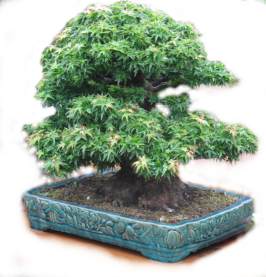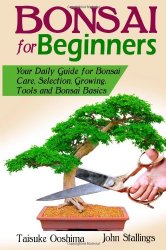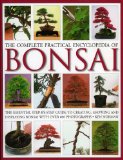
You can see in the picture of the bonsai above one of the important aspects of the art -The shallow dish. This is one of the ways that the tree is kept small -with a shallow dish that only holds so much in nutrients and in roots. This is an important aspect. But another aspect is the sculpting of the tree. This is done by selective and careful pruning and by wiring. The pruning keeps the tree small and the wiring will force it into specific shapes that are aesthetically pleasing.
So, the art of bonsai has three major components:
- managing the root system
- Pruning the branches
- wiring the shape
And beyond this there are the normal caring for plant duties that come along with it including sunlight, watering, and pest control. But these duties can be more demanding with a bonsai. For example, because you use a shallow dish with little soil there is no water retention so you can't water a bonsai like you would a normal house plant. You have to water it more frequently, often daily.
There are a lot of different aspects to watering bonsai which include the normal requirements for the type of tree you have and there are things to think about like bonsai are often watered less in the spring when they are getting their new shoots. This reduced watering will reduce the size of the leaves that are grown.
Dormancy Period of the Tree
Many types of trees need to go through a yearly dormancy period. This is winter time. It is important that they do this because it is genetically programmed into them. You have to allow the trees to do this and be prepared for it.
Know your particular type of tree
This is the most important thing when it comes to bonsai care and growing. You have to know the specifics of your tree species. Does it require a dormancy period? Can it do well indoors? Or should it be kept outdoors? How much watering does it need and what kind of care and sunlight should it get? So, be sure to research your exact tree species!
As a review here are the most important things to know when starting out in the art of Bonsai:
- Know the specific requirements of your tree
- Watering needs are dramatically different that other plants (you probably have to water daily and in hot weather you may have to water more than once a day)
- Your tree may need a dormancy period (winter time) and this is perfectly normal. Sometimes people assume their tree has died when it actually hasn't!
- Will it be an indoor or outdoor bonsai?
What do you do when Growing and caring for a Bonsai?
I have a care timeline that you can look at to get a sense for the care of a bonsai through all these steps: the bonsai care time line
Daily Care:First and foremost you monitor it every day! Yup, every day. In the fast paced world in which we live this can be quite a shock to a person. We all have so many commitments and it can often seem difficult to commit to anything like this but this is what you have to do. A bonsai can be hardy and live a century or more but because the whole system is developed in a way that miniaturizes the tree things can quickly go wrong.
So, monitor it every day, and be sure that it gets the required sunlight for the particular species of tree. And water it every day and on very hot days you might need to water it more than once.
Feeding: This is a very important aspect of bonsai. You should feed your tree some kind of an organic fertilizer. Because the root system is stunted and cut, and there is so little soil it can be difficult for your tree to get enough nutrients so you have to feed! But, you can over feed. Too many nutrients or too much chemical fertilizer can damage the roots and the tree. So, too little or too much can both be detrimental to your tree. There are guidelines for this and I will cover them. For now think about using a totally organic fertilizer. It will make a difference.
Re-potting: For most young and fast growing trees you should re-pot them every two years. This means taking it out of it's pot, cutting away about the bottom third of the roots, cleaning out some of the soil around the roots then replanting it in a new dish (with fresh soil) that is about 1 inch larger than the previous dish. For conifers this process can be done on a less regular bases (usually every 2-5 years).
Pruning: This is where you use scissors to cut away branches of the tree. This is most often done in spring before new shoots appear. And this is how you establish some of the shape of the tree.
Wiring: This is the method of curling wire around various parts of the tree to guide and mold it and parts of it in the desired shapes.
Over Wintering: This is the process of allowing the tree to go into its winter dormant state. Often they are placed outdoors in some kind of a structure like a small greenhouse. This is a necessary part of the life cycle of the tree and if it not possible to keep outdoors in needs to be kept in the coolest place possible and not brought into the heat of the house prematurely or it will sprout. Different trees have different requirements and different tolerances.

Bonsai for Beginners Book: Your Daily Guide for Bonsai Tree Care, Selection, Growing, Tools and Fundamental Bonsai Basics
If you want to know how to grow Bonsai trees, how to choose them, how to take proper care of them, what tools you need and all the essential basics you need as a beginner, you’ve found the right book.
The Bonsai for Beginners Book: Your Daily Guide for Bonsai Tree Care, Selection, Growing, Tools and Fundamental Bonsai Basics will take you on a journey where you will discover the secrets behind Bonsai tree selection, caring and growing. Everything you need to know in order to see your bonsai tree flourish is included inside.
 
The Complete Practical Encyclopedia of Bonsai: The essential step-by-step guide to creating, growing, and displaying bonsai with over 800 photographs This book defines and describes the ancient craft of bonsai. The techniques of this precise art form are clearly described, and provides a stunning and fully comprehensive reference that is ideal for the beginner as well as the more experienced bonsai artist. This book defines and describes the ancient craft of bonsai. The techniques of this precise art form are clearly described, and provides a stunning and fully comprehensive reference that is ideal for the beginner as well as the more experienced bonsai artist.
|
![]()








